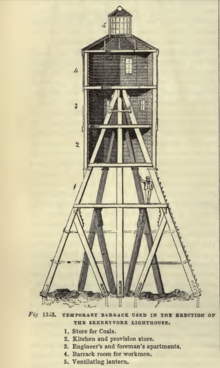Skerryvore
Skerryvore (from the Gaelic An Sgeir Mhòr meaning "The Great Skerry") is a remote island that lies off the west coast of Scotland, 11 nautical miles (20 kilometres) southwest of Tiree.
[5] The shore station was at Hynish on Tiree (which now houses the Skerryvore Lighthouse Museum); operations were later transferred to Erraid, west of Mull.
[7][8] In pre-historic times the rocks that now form Skerryvore were covered by the ice sheets that spread from Scotland out into the Atlantic Ocean beyond the Outer Hebrides.
[10] Steadily rising sea levels would then have slowly isolated and finally all but submerged the shoals of Skerryvore, a barrier of innumerable metamorphic remnants that stretch for 8 miles (13 kilometres) lying in a south-westerly direction.
Robert Stevenson, chief engineer of the Northern Lighthouse Board (NLB) landed on the reef in 1804 and reported on the need for a beacon of some kind there.
[16] Scott wrote: Quiet perseverance on the part of Mr S, and great kicking, bouncing and squabbling upon that of the yacht, who seems to like the idea of Skerry Vhor as little as the Commissioners.
At length, by dint of exertion, come in sight of this long ridge of rocks (chiefly under water), on which the tide breaks in a most tremendous style.
It will be a most desolate position for a lighthouse, the Bell Rock and Eddystone a joke to it, for the nearest land is the wild island of Tyree, at 14 miles distance.
[17]Later that year an Act of Parliament was passed enabling construction of a lighthouse, yet despite pleas for a light arriving almost weekly at the NLB, events proceeded only slowly.
[26] Work on the new facilities began in 1837; granite blocks were quarried from Mull and brought to the village to be cut and shaped before being shipped out to the reef.
Several cottages for the keepers were built in 1844 from the same stone as well as a massive pier and a tall granite tower to enable signalling to and from Skerryvore itself.
[27] Stevenson remarked that the hive of activity there contrasted with the "desolation and misery" he imagined to be the lot of the surrounding population.
The first work to be undertaken on Skerryvore itself was the construction of a six-legged frame on top of which a wooden barrack to house 40 men was placed.
Stevenson and 21 workmen arrived on board the sailing vessel Pharos and began to unload the barrack, whose massive legs were set into holes blasted out of the rock.
It began: "Dear Sir, I am extremely sorry to inform you that the barrack erected on Skerryvore Rock has totally disappeared.
Yet in the midst of this torn and fissured surface we suddenly came on a magnificent circular floor, 42 ft [12.8 m] in diameter, as level as water, and as smooth as a billiard table.
During the summer of 1840 the steamer was unable to reach the reef for fourteen consecutive days, and on another occasion no landings were possible for seven weeks and supplies began to run low.
When work ceased again in the autumn, 800 tons of granite standing 8 feet 2 inches (2.49 m) high stood on Skerryvore, and up to 80 craftsmen continued to labour on the blocks at Hynish all winter.
It is a credit to Stevenson, his foreman Charles Stewart, and Captain Macurich the landing master, that not a single life was lost during the construction.
[48] The adverse conditions faced by the keepers resulted in them receiving additional payments in kind, but the remote location suited some veterans.
The latter was involved in a dramatic rescue when the liner Labrador en route from Halifax, Nova Scotia to Liverpool ran aground on the nearby Mackenzie's Rock in 1899.
The lifeboats were manned and two made it to Mull, but one with eighteen passengers reached the lighthouse where they were looked after for two and a half days before they could be taken to the mainland.
Should no reply be made by the hoisting of the ball, the schooner, hurried from its wet dock, is put to sea and steers for the lighthouse....
[51]The visual similarity between Skerryvore and Dubh Artach 20 miles (32 kilometres) to the south east, led to the NLB painting a distinctive red band round the middle section of the latter in 1890.
Other than the signal tower, the land and buildings on Tiree were sold to George Campbell, 8th Duke of Argyll who had witnessed the laying of the first stone on Skerryvore fifty-two years previously.
The keepers had no time to raise the alarm and were driven out of the lighthouse onto the rocks but rescued the next day when the relief vessel arrived as part of its regular schedule.
The heat of the fire caused damage to both the interior and the structure and a lightship and series of temporary lights were installed during reconstruction.
The Hynish tower has been converted to house the Skerryvore Lighthouse Museum, run by the Hebridean Trust who have also restored the pier.



